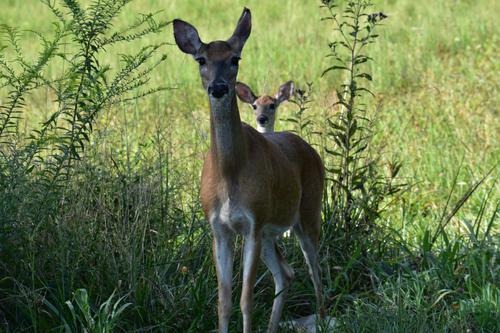当前位置:
X-MOL 学术
›
Ecol. Evol.
›
论文详情
Our official English website, www.x-mol.net, welcomes your
feedback! (Note: you will need to create a separate account there.)
Influence of natal habitat preference on habitat selection during extra-home range movements in a large ungulate
Ecology and Evolution ( IF 2.3 ) Pub Date : 2023-02-03 , DOI: 10.1002/ece3.9794 Nathan D Hooven 1, 2 , Matthew T Springer 2 , Clayton K Nielsen 3 , Eric M Schauber 4
Ecology and Evolution ( IF 2.3 ) Pub Date : 2023-02-03 , DOI: 10.1002/ece3.9794 Nathan D Hooven 1, 2 , Matthew T Springer 2 , Clayton K Nielsen 3 , Eric M Schauber 4
Affiliation

|
Natal habitat preference induction (NHPI) occurs when animals exhibit a preference for new habitat that is similar to that which they experienced in their natal environment, potentially leading to post-dispersal success. While the study of NHPI is typically focused on post-settlement home ranges, we investigated how this behavior may manifest during extra-home range movements (EHRMs), both to identify exploratory prospecting behavior and assess how natal habitat cues may influence path selection before settlement. We analyzed GPS collar relocation data collected during 79 EHRMs made by 34 juvenile and subadult white-tailed deer (Odocoileus virginianus) across an agricultural landscape with highly fragmented forests in Illinois, USA. We developed a workflow to measure multidimensional natal habitat dissimilarity for each EHRM relocation and fit step-selection functions to evaluate whether natal habitat similarity explained habitat selection along movement paths. Across seasons, selection for natal habitat similarity was generally weak during excursive movements, but strong during dispersals, indicating that NHPI is manifested in dispersal habitat selection in this study system and bolstering the hypothesis that excursive movements differ functionally from dispersal. Our approach for extending the NHPI hypothesis to behavior during EHRMs can be applied to a variety of taxa and can expand our understanding of how individual behavioral variation and early life experience may shape connectivity and resistance across landscapes.
中文翻译:

出生栖息地偏好对大型有蹄类动物外出活动时栖息地选择的影响
当动物表现出对与其在出生环境中经历的环境相似的新栖息地的偏好时,就会发生出生栖息地偏好诱导(NHPI),这可能会导致扩散后的成功。虽然 NHPI 的研究通常集中在定居后的活动范围,但我们研究了这种行为在家庭活动范围外移动 (EHRM) 期间如何表现,以识别探索性勘探行为并评估出生栖息地线索如何影响定居前的路径选择。我们分析了 34 只幼年和亚成年白尾鹿 ( Odocoileus virginianus ) 在美国伊利诺伊州森林高度分散的农业景观中进行 79 次 EHRM 时收集的 GPS 项圈重新定位数据。我们开发了一个工作流程来测量每个 EHRM 搬迁的多维出生栖息地差异,并拟合步骤选择函数来评估出生栖息地相似性是否解释了沿移动路径的栖息地选择。跨季节,迁徙运动期间对出生栖息地相似性的选择普遍较弱,但在扩散过程中较强,表明NHPI在本研究系统中的扩散栖息地选择中得到体现,并支持了迁徙运动与扩散在功能上不同的假设。我们将 NHPI 假设扩展到 EHRM 期间的行为的方法可以应用于各种分类群,并且可以扩展我们对个体行为变异和早期生活经历如何影响跨景观的连通性和阻力的理解。
更新日期:2023-02-04
中文翻译:

出生栖息地偏好对大型有蹄类动物外出活动时栖息地选择的影响
当动物表现出对与其在出生环境中经历的环境相似的新栖息地的偏好时,就会发生出生栖息地偏好诱导(NHPI),这可能会导致扩散后的成功。虽然 NHPI 的研究通常集中在定居后的活动范围,但我们研究了这种行为在家庭活动范围外移动 (EHRM) 期间如何表现,以识别探索性勘探行为并评估出生栖息地线索如何影响定居前的路径选择。我们分析了 34 只幼年和亚成年白尾鹿 ( Odocoileus virginianus ) 在美国伊利诺伊州森林高度分散的农业景观中进行 79 次 EHRM 时收集的 GPS 项圈重新定位数据。我们开发了一个工作流程来测量每个 EHRM 搬迁的多维出生栖息地差异,并拟合步骤选择函数来评估出生栖息地相似性是否解释了沿移动路径的栖息地选择。跨季节,迁徙运动期间对出生栖息地相似性的选择普遍较弱,但在扩散过程中较强,表明NHPI在本研究系统中的扩散栖息地选择中得到体现,并支持了迁徙运动与扩散在功能上不同的假设。我们将 NHPI 假设扩展到 EHRM 期间的行为的方法可以应用于各种分类群,并且可以扩展我们对个体行为变异和早期生活经历如何影响跨景观的连通性和阻力的理解。















































 京公网安备 11010802027423号
京公网安备 11010802027423号